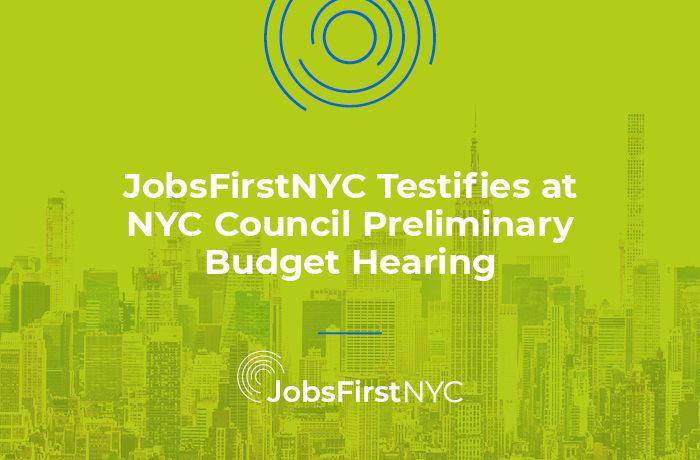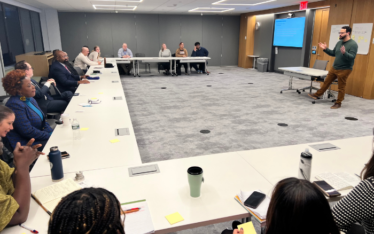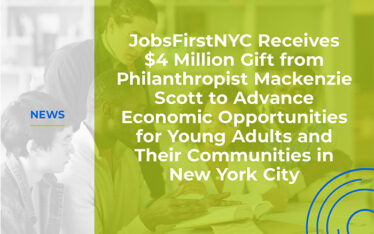Youth Services and Finance Committees Joint Preliminary Budget – March 6, 2017
Good afternoon, Chairpersons Eugene and Ferreras-Copeland, and other distinguished Council Members of the Youth Services and Finance Committees. My name is Chantella Mitchell and I am the Policy and Program Associate at JobsFirstNYC, a policy to practice intermediary focused on the issues of young adults who are out of school and out of work or underemployed.
For ten years, JobsFirstNYC has been developing and supporting innovative strategies to support out-of-school, out-of-work young New Yorkers. We are here today continuing to advocate for this population’s inclusion in the mayor’s and city council’s visions for a more equitable city.
We recently released brand new data on the out-of-school, out-of-work population in New York City. The data show that with improvements in the economy, and through the diligent work of workforce and education providers and advocates, more young people are working and in school since the recession. However, the numbers are still too high, and the disparities among neighborhoods are as stark as ever. More than 136,000 18-24-year-olds are neither working nor in school, and in parts of the South Bronx and Central Brooklyn, where rates are the highest, 30 percent or more of young residents are out-of-school and out-of-work.
Building on our work over the years, JobsFirstNYC recommends two areas of investment to the Youth Services Committee. First, we recommend the creation of a large-scaled “Business for Young New Yorkers” public campaign; and second, we urge you to increase investments in effective training and employment opportunities for living wage careers in under-resourced neighborhoods.
As I mentioned, the rates of out-of-school, out-of-work young adults vary drastically from neighborhood to neighborhood. For this reason, JobsFirstNYC has taken a neighborhood, or place-based, approach to developing strategies to connect young adults and local businesses. Last month, in the South Bronx, the NYC neighborhood with largest number of young people in the city, but the highest rates of out-of-school, out-of-work young adults, we successfully convened dozens of small and medium-sized Bronx employers to share the plethora of opportunities to partner with public and nonprofit workforce providers to source talent. On the Lower East Side, where booming economic development has multiplied the number of career opportunities over the last decade, we worked with community-based organizations to develop the Lower East Side Employment Network – a collaboration of CBOs and Community Board 3 that helps companies recruit, hire, and retain quality candidates at lower operational costs. LESEN ensures that local residents are able to benefit from the neighborhood’s economic growth by collectively serving 10,000 job seekers and 300 businesses every year. Finally, we are working with local employers in our emerging seasonal employer collaborative that will allow leading businesses in New York with high volumes of seasonal workers to work together to design and lead collective efforts to train, hire, and retain local young workers interested in year-round employment.
These and other efforts should be replicated, on a large scale to best match young workers with local employers for sustained success in in-demand fields. We recommend that our local government, with its vast array of business relationships, launch a citywide campaign to encourage private sector employers to developand hire local young talent. A strong example of small businesses pledging to developing talent is a project underway between the Small Business Majority and U.S. Small Business Administration called Small Biz 4 Youth Campaign.
New York City has taken steps to improve the quality of services delivered to OSOW young adults. However, many young adults remain disconnected from training and employment opportunities for living-wage careers. In 2015, half of all jobs in New York State required a training and education beyond high school, but not a four-year degree, these are often called middle skills jobs. Many excellent programs in New York City are providing sectoral training and certificate programs for middle skills jobs, but the need and demand for these programs – from both young adults and employers – far exceeds the city’s investment. We urge the city to create and expand successful programs training young people for living wage, middle skills careers. This includes sectoral programming, apprenticeships, and certificate programs.
Other areas for increased investment in training and employment include: creating an initiative to help young adults access employment in the public sector; strengthening retention and wrap-around supports for young workers after they’ve successfully secured employment; and evaluating and strengthening the various new youth opportunity centers throughout the city. We first recommended that the city create a network of one-stop centers that connect young people to jobs and to the educational, training, and support services in our 2014 paper Unleashing the Economic Opportunity of the 35 Percent. Since then, a crop of new centers has emerged throughout the city. From the new SBS youth-focused Workforce1 Center in the Bronx, to the Manhattan DA’s recently announced grants for five centers throughout Manhattan. We encourage the city to evaluate these new centers to ensure that they are coordinated to provide a truly comprehensive list of effective employment services, and that they are placed in the neighborhoods with the highest needs and staffed by organizations with the most successful histories serving this population.
Just last year, Comptroller Stringer stated the following when he released a report highlighting the dire situation of job and earning opportunities for young New Yorkers: “Millennials are doing their part for New York City – they are politically involved, culturally engaged, and highly motivated. This generation is overcoming setbacks and changing the way we work, live and communicate. Now it’s time for the rest of us to do our part and put policies in place that will help this powerful group settle down in New York City, start their careers, and raise families here, so our economy can continue to grow.” >
Now is the time to put that call to action in place. We urge the city to make the investments necessary to ensure that young New Yorkers can share in our city’s economic success.
Thank you,
Chantella Mitchell, JobsFirstNYC
cmitchell@jobsfirstnyc.org





